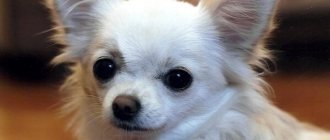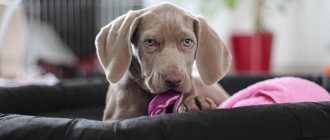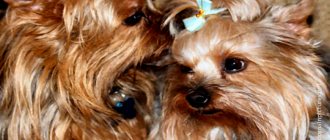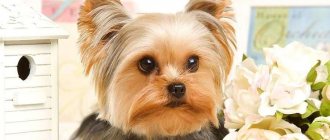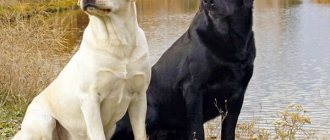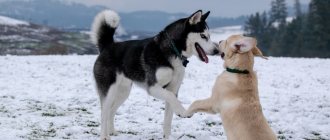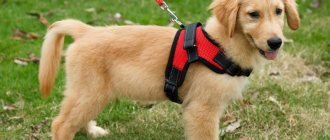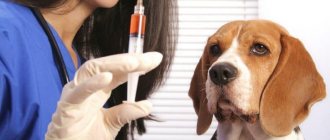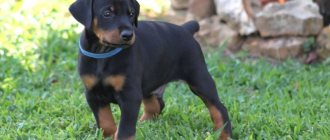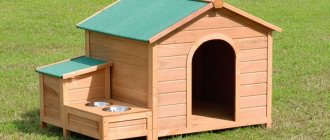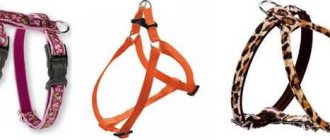Every pug owner has thought about getting puppies from their pet at least once in their life, but it is important to consider that there are many nuances behind such a delicate matter.
You need to take into account not only the age and health of your dog, but also weight, height, character, suitable days for mating, place, choice of a mate and, of course, your readiness - both financial and moral.
Therefore, as soon as you have made such a decision, remember that absolutely all responsibility for the dog and its future puppies falls entirely on your shoulders. And if you are not entirely confident in your abilities, you can always turn to a professional puppy breeding instructor for help, who will competently supervise such a complex process.
When and at what age can you breed a dog?
For the first time, pugs come into heat at the age of 6 to 10 months, but you cannot start breeding at such an early age - you need to let the pet become physically and mentally stronger.
The first mating should take place no earlier than 15 months for a female and 12 months for a male. This information cannot be ignored, since pregnancy at this age is not the most favorable factor and can have a detrimental effect on the health of your pet.
At 10 months, the dog looks quite mature in appearance, but its joints and muscles are not yet fully developed and there is a risk that the young pug’s growth may stop, its back will become depressed, and the animal will also receive psychological trauma and rejected puppies. As a result, such a dog can no longer be used to reproduce offspring.
Is mating necessary?
Many people who are far from cynology believe that a bitch must give birth at least once, and a male dog must be “introduced” to a girl at least once. Otherwise, they say, the dog will feel deprived and may even get sick.
In fact, animals do not feel the need to mate. In a wild environment, in packs of predatory canines, not all males have offspring, but only those who have proven their strength, endurance and perseverance by defeating many rivals in battle for a female.
And the same she-wolves do not all give birth to wolf cubs, since they also have their own hierarchy and lower-ranking females are not allowed to breed. At the same time, none of the “childless” animals feel deprived in any way and, even more so, do not get sick due to the lack of sex life.
People, having taken upon themselves the functions of creators of factory breeds, including pugs, often abuse this and use animals in breeding that can do nothing to improve the gene pool of future generations, and sometimes only spoil it.
Important! Only pugs that have high show scores and come from healthy lines should be used for breeding.
Mating, especially early, will not bring anything good to a non-breeding dog and its offspring. A male dog, after going for a walk once, will begin to knit everything in a row, and a bitch who has given birth only once may later develop a pronounced false pregnancy.
Puppies that do not have documents of origin will cost much less and, as a result, you will have to spend much more money on raising them than you can get from selling them. At the same time, no one can guarantee that a puppy purchased inexpensively will be in good conditions and will live a long and happy life in a loving family.
Therefore, dogs should be bred only if they are excellent in appearance, are not carriers of hereditary diseases, and can improve the gene pool.
On what day of heat should I take my pug?
One of the most pressing questions for dog owners. On the one hand, days 10-14 are considered ideal, but on the other hand, do not forget that each organism has its own characteristics, so do not rush to rush to mating. Conclusion: there are no correct days; you need to monitor your pet individually.
You need to monitor the progress of the estrus and the behavior of the bitch immediately from the first estrus, and not when you are about to take her for mating. You can do an experiment and (with the owner’s consent) bring her to a male dog. Next, we observe the dog’s reaction.
If he growls/snarls/is afraid, then it’s too early (the behavior is typical for the first days of estrus). If he flirts, but does not allow the male to jump on him, then ovulation is approaching and you need to be on guard. Retracts the tail, bends the back, places a loop, then the next 2-3 days will be suitable for mating.
It happens that a bitch is aggressive towards males throughout her entire heat. What to do in this situation? You need to observe her physical changes:
- frequent urination;
- disobedience;
- attempts to escape;
- overly aggressive or playful behavior;
- intense shedding;
- here we introduce softening, as well as an increase in the loop and a change in the color of the discharge - instead of bloody discharge, lighter, pinkish discharge appears.
But we cannot rely only on the last factor. It happens that during estrus there is practically no blood and owners often miss its onset.
IMPORTANT: pugs usually come into heat twice a year, but they can bear puppies no more than once every 1.5-2 years.
How to protect a girl from an unplanned emergency?
To prevent the bitch from accidentally mating, during heat you need to take her out for walks only on a leash. At the same time, it is necessary to avoid the company of other dogs. If a female pug lives in a private house, then it is better not to let her out into the yard unless there is a reliable fence that other people’s dogs cannot jump over or crawl under.
In the event that, in addition to the female pug, there are also males of the same or another breed living in the house, it is necessary to isolate the bitch from them, not allowing even short-term contact with them.
Important! Most unscheduled matings are the result of irresponsibility and frivolity of dog owners and only occasionally are the result of an accident when, for example, a bitch left in a foster home was mated there.
Choosing a Healthy Couple
The choice of a couple must be approached no less responsibly than the process itself. After all, the health of both partners determines how the future offspring will turn out.
Future parents can be analyzed by participating in exhibitions and being assessed by various experts who will help identify shortcomings that are often found in almost every dog. And based on the identified defects that are inherent in the parents (if any), it is possible to draw up the desired portrait of future children.
But do not forget that there are certain taboos under which you should never breed puppies:
- the dog is not a purebred pug, but only vaguely resembles this breed;
- the dog has genetic diseases or serious anatomical defects (the most common: aseptic necrosis of the femoral head, necrotizing meningoencephalitis, inflammation of the uterus, brachycephalic syndrome);
- the dog has undergone complex surgical interventions or serious injuries;
- the dog has problems with the cardiovascular system;
- the dog is sick/weak/has problems with excess weight;
- The dog is too large or too small for this breed.
If your pet or its partner fits at least one of these points, then you should not resort to mating.
Preparation for mating
Preparation must begin three months before the heat. Before going into heat, you need to undergo a preventive examination by a veterinarian, take blood and stool tests for eggworms, cure existing inflammations, and also make sure that all necessary vaccinations are completed on time.
A month before mating, you need to carry out deworming and rid your pet of fleas. If you are late with anthelmintic drugs, this threatens the resorption of embryos in the early stages or the loss of offspring at 4-5 weeks of pregnancy.
For a male dog, you need to undergo a preventive examination by a veterinarian and undergo tests once every six months. Treat for fleas no later than a week before mating, and deworming is carried out as usual (once every 3-4 months). But if the analysis shows the presence of worms, then the problem must be eliminated immediately before mating.
Another important point for both parents is weight control, because Pugs have a tendency to become obese. For a bitch, being overweight does not threaten pregnancy and complications in the future, but it will be difficult and uncomfortable for a dog to climb on top of a girl, he will be out of breath and get tired faster.
Therefore, it is worth unloading animals from excess fat prematurely and this requires only a balanced diet and moderate physical activity.
Signs of readiness
In this situation, it is necessary to monitor the behavior of the bitch.
A signal of its readiness is the animal’s close interest in nearby males, impulses to escape from its owners, restlessness and playfulness, as well as frequent urination.
From the moment the estrus begins, it is better not to let the animal go outside without a leash, in order to prevent any accidental mating with a non-pedigreed male.
Pairing Instructions
Make sure the animals are as comfortable as possible. If mating occurs in the summer, then it is better to prescribe it in the morning or evening.
Animals (especially males) need to be given a good walk 2 hours before crossing so that they become more loving and do not need to be fed.
The mating itself should be carried out on the male’s territory so that he feels more confident, especially if he has little experience in amorous matters.
It is also advisable to have an experienced breeder present who can professionally monitor the process and help if difficulties arise.
When the animals become comfortable, a period of courtship and flirtation begins, which is the beginning of sexual intercourse. The male will carefully sniff the female’s intimate place, as he is excited by this smell, and the female will allow him to lick the loop and then begin mating.
But sometimes not everything goes smoothly: the bitch can become nervous, afraid, or behave aggressively and not let the male near. In this case, you or the breeder will have to intervene.
It will be necessary to carry out the mating on a non-slip table, holding the pug by the front paws. If necessary, use anti-bite gloves if the female is very aggressive, and a muzzle, but only as a last resort, because this can humiliate the dog.
If the female is larger than the gentleman, then a special stand or a thick book can be placed on his hind legs. You may need to hold the female's rear and adjust the position of her loop.
After this process is completed, the male will turn in the opposite direction (if necessary, help him) and the genitals of the animals will remain in the “lock” for 10-15 minutes.
Bonding may take up to an hour or more, but this is not a reason to worry, since in this position the process of fertilization of the egg occurs.
Mating may not work out right away, so to be on the safe side, it is recommended to repeat the mating the next day after the first time in order to consolidate the result, but do not forget to give the animals rest so as not to overtire them.
Labor activity
By the 50th day, the pregnant female begins to look for a place for the upcoming birth. Pets give birth in a prepared place, and usually at home.
At this moment, pet owners should take care of preparing a corner or enclosure where the puppies will be born.
The fact that childbirth is approaching can be understood by the following signs::
- drooping belly;
- decrease in body temperature to 37 degrees;
- refusal of the female to eat in some cases;
- the dog tries to find a place, and also breathes heavily and does not leave the owners.
When all the indicated signs appear after 6-7 hours, labor begins.
A box with a hole that will serve as a door may well become a home for the mother and puppies. It is recommended to cover the bottom of the box with foam rubber, the thickness of which should be at least 5 cm. The foam rubber should also be covered with a warm blanket.
You should also prepare a separate box with a heating pad, where you will need to put the emerging offspring.
For delivery, you will also need soft wipes and sheets, as well as gauze swabs to clear the puppies' mouths and noses of fluids..
At the same time, you should prepare scissors, brilliant green, cotton wool, two containers with hot and cold water. Just in case, it is necessary to notify the veterinarian, who will be able to go urgently if necessary.
During the birth process, your four-legged pet can be calmed with affection, stroking the animal.
In a situation where a new mother does not lick her newly born puppies, she will need to wipe them with a dry cloth..
What to do after
Within a month after mating, you can determine whether the dog is pregnant or not. Her behavior changes, the female becomes lethargic, begins to sleep and eat more, gains weight, and there is a rare urge to urinate.
According to these signs, offspring are expected in 2 months, but to find out for sure, you should contact a veterinary clinic (the visit is scheduled for 6-7 weeks after mating). There the dog will undergo an ultrasound and will be provided with all the necessary recommendations for pregnancy management.
Course of pregnancy
Pugs carry puppies for 2 months.
This period is characterized by a state of lethargy and longer sleep, good appetite, weight gain, and rare urination can be considered the main signs of pregnancy.
NOTE!
However, to ensure that the result is achieved, the female’s owners should take the animal to the veterinarian for an ultrasound.
Common mistakes
Unfortunately, due to inexperience and worries about his pet, the owner is not always able to avoid mistakes that can negatively affect the animal in the future.
- In addition to the fact that you cannot breed dogs that are too young or too old, you also cannot force animals towards each other, so as not to intensify the stressful situation even more. It's better to give them time to get to know each other and play with each other.
- During the act itself, the female can and sometimes needs to adjust the noose, but under no circumstances should she touch the male’s genitals, as this will scare him away and he will not want to cover the female. While the animals are in the “castle”, they should not be allowed to squirm around - this is fraught with adverse consequences and injuries.
- Even after the pugs come unglued from each other, dog owners think that the work is completed, but the most important moments remain ahead. After intercourse, you need to put the girl on her back, raise the back of her body so that the sperm flows deeper. In addition, you should not let her pee earlier than two hours after mating.
- As for our champion, as a precaution after mating, his genitals need to be treated with Miramistin. If this procedure is neglected, various infections can enter the dog’s body.
- During pregnancy, also try to give your dog special attention and proper care: walk a lot, monitor nutrition and well-being, do not neglect going to the veterinarian if you notice strange changes in the behavior of the animal or in itself, because an advanced disease or even an innocent infection can tragically affect future offspring and the dog as a whole.
- Manufacturers' choice
- Sexual cycles
- Caring for a pregnant dog
- Childbirth
- Caring for a whelping dog
- Complications during pregnancy and childbirth
- Raising and raising a puppy
- Puppy growth and development
- The puppy's place in the house
- Walking a puppy
- Puppy care
- Puppy care items
- Puppy food
6. Breeding pugs
Breeding pugs is one of the most difficult processes. The dog owner must be familiar not only with its physiology, but also with the basics of veterinary medicine.
In order to get a healthy litter, the dog owner needs to become familiar with the basic physiology of animal reproduction, study the basic rules for selecting sires, and some features of caring for a pregnant bitch and newborn puppies.
Manufacturers' choice
The correct choice of sires is of paramount importance to obtain a healthy litter that fully complies with the standard.
In this case, factors such as the general physical development of the dog, its constitution and breed characteristics should be taken into account. The timing of puberty in dogs primarily depends on the sex of the animal. For example, females are capable of breeding at the age of 6-8 months, and males - 12-16 months.
However, in order to obtain a viable, healthy litter, it is necessary to select individuals that have reached the general physical maturity of the body. Such animals should not be too young or very old. The reproductive capacity of female pugs is most developed at the age of 1.5–6 years, of male pugs – 2–7 years.
In order to obtain a litter that meets the standard, it is necessary to select the right sires. The dogs’ physical health, appearance, and type of behavior are important. You should not choose overly aggressive, easily excitable or cowardly dogs as breeders.
Sexual cycles
Bitches have sexual cycles twice a year. Males retain the ability to reproduce throughout the year. There are 3 phases of the reproductive cycle in females.
1st phase – precursor, or proestrum. The period lasts on average 5–8 days. At this time, the dog becomes restless, its appetite weakens, the mammary glands swell, the size of the external genital organs increases, and bloody discharge from the vagina is observed.
2nd phase – estrus, or estrus. The period lasts 6–10 days. During this time, dogs experience a strong sexual desire called heat. The amount of bloody discharge decreases somewhat and becomes transparent. During estrus, ovulation occurs and the eggs become capable of fertilization.
3rd phase – post-estrus, or metoestrum. The period lasts approximately 30–60 days. At this time, the dogs' sexual desire decreases sharply, after which it completely disappears. The discharge stops, the genitals acquire normal size.
It is recommended to breed dogs on the 9th–12th day of the reproductive cycle. After 1–2 days, mating should be repeated to ensure fertilization of the eggs.
Sexual intercourse in dogs lasts approximately 40–50 minutes. Animals should not be separated until it is completed.
If dogs show aggressiveness during mating, it is recommended to put muzzles on them.
Mating is recommended to be done in the morning, after a walk, before feeding the dog or 4-6 hours after that. Before mating, animals should be given the opportunity to get comfortable in an unfamiliar environment and sniff each other. Usually they bring a bitch to a dog.
It is not recommended to breed a bitch more than once a year, since more frequent matings can lead to exhaustion of her body and the birth of inferior, weakened offspring.
Males at the age of 2–3 years are often used for mating 6–8 times a year, at the age of 3–8 years – 20–30 times.
Fertilization occurs when sperm and egg fuse. Pregnancy in dogs is multiple and lasts approximately 62 days. Signs of pregnancy usually appear at 2 months. At the same time, the dog’s body weight and the volume of its abdomen increase, its appetite increases, and the animal’s behavior changes.
Carefully palpating the bitch's abdomen will help determine the approximate number of embryos.
Caring for a pregnant dog
During the puppy period, the dog needs to be carefully cared for. Particular attention is paid to the animal’s diet. For normal pregnancy and proper development of embryos, the bitch should be provided with a balanced diet, giving her high-quality, easily digestible food containing large amounts of proteins, minerals and vitamins. You can add bone meal, fish oil, fresh vegetables and fruits, as well as vitamin preparations to your food.
During this period, the amount of food is increased by giving the dog meat and dairy products.
However, we should not forget that overfeeding, as well as lack of food, has a negative effect on pregnancy. It is recommended to feed the puppy 3 times a day. A pregnant dog needs special care.
Throughout pregnancy, the dog should be walked daily for at least 2 hours.
This is necessary to supply the animal’s body with oxygen, improve metabolism and strengthen muscles. In the second half of pregnancy, the dog should not be allowed to make sudden movements.
Before giving birth, it is recommended to prepare in advance replacement bedding, sterile gauze wipes, hot water, scissors and boiled linen threads.
Childbirth
Proper care during pregnancy ensures that the dog’s birth proceeds without complications and often does not require human intervention.
The owner must first prepare the place where the dog is to whelp. For this purpose, it is recommended to set aside a secluded, dimly lit corner where the animal will not be disturbed. The floor mat must be clean.
2-3 days before the expected birth, colostrum begins to be released from the bitch’s nipples. At the same time, the animal’s body temperature decreases by 1–2 °C.
Many experts believe that animals should not be allowed to eat all the afterbirth, as this often causes digestive upset.
In order to most accurately determine the due date, it is necessary to regularly measure the dog’s body temperature in the last days of pregnancy. Just before giving birth, the animal refuses food and becomes restless.
The onset of contractions, indicating contraction of the muscles of the uterus, cause painful sensations, causing the dog to whine, periodically change body position and move from one place to another.
Contractions are initially short, with an interval of 15–30 minutes. Then they become longer, breaks are reduced to 2–5 minutes.
The process of dilating the cervix takes an average of 3–8 hours. After the membranes rupture, contractions begin to alternate with pushing, which is a contraction of the abdominal muscles.
The duration of the birth process depends on the number of puppies in the litter and averages 10–24 hours. Puppies appear at different intervals. During prolonged labor, it is recommended to take the dog out for a short walk, giving it the opportunity to empty its bladder and bowels. In addition, physical activity stimulates labor.
After the birth of the next puppy, the dog bites the umbilical cord, chews and then eats the fetal membrane, licks the newborns, pushing them towards the nipples.
Usually the placenta comes out immediately after the birth of the puppy, and sometimes 2-3 hours after the end of labor. If after this time the placenta has not come out, it is necessary to give the dog an injection of a drug (after consulting with a veterinarian) that causes uterine contractions.
We should not forget that delayed placenta often leads to the development of various inflammatory processes.
If after the birth of the puppy the dog has not chewed the fetal membrane, you need to carefully cut it, then tear it apart with your hands and tie the umbilical cord in two places at a distance of 2 and 6 cm from the abdominal wall of the puppy.
After this, the umbilical cord is cut with scissors between the dressings and the wound is treated with iodine. Then the puppy's body is thoroughly wiped with a clean napkin.
After giving birth, it is not recommended to disturb the dog or handle newborn puppies for 24 hours. If a dog has a developed maternal instinct, it can take care of its offspring on its own.
Caring for a whelping dog
After giving birth, the dog must be protected from physical activity. It is necessary to halve the duration of walking (especially in cold weather), and also take appropriate preventive measures to prevent the occurrence of various diseases.
In the area reserved for dogs and newborn puppies, the bedding should be changed regularly to avoid contamination.
It is advisable to select a large and comfortable box for dogs and puppies.
Place for dogs and puppies
It is recommended to wipe the dog’s genitals and mammary glands 2 times a day with a cotton swab dipped in a weak solution of potassium permanganate.
For 1–2 weeks after birth, the dog experiences mucous discharge from the vagina. Grayish and then colorless discharge is considered normal. If they acquire an unpleasant odor and a dark green color, you should immediately contact your veterinarian.
When a dog is feeding puppies, it is necessary to increase the amount of food given to the dog. The diet should contain meat, milk and vitamin supplements.
If the dog does not lactate or refuses to feed the puppies, the owner needs to take care of feeding them. For artificial feeding, cow's milk or infant formula is used, heated to a temperature of 38–39 °C. Puppies are fed from a bottle with a nipple.
Mother's milk contains all the nutritional elements necessary for newborn puppies and therefore plays an important role in their development.
Complications during pregnancy and childbirth
Often, pregnancy and then the birth of dogs are accompanied by various complications caused mainly by metabolic disorders, pathology of internal organs or improper care of the animal.
False pregnancy occurs after mating of dogs in the absence of fertilization. Its symptoms are in many ways similar to the signs of real pregnancy and manifest themselves in the animal’s excited state, an enlarged abdomen, and the appearance of milk.
A sick dog should be taken to a veterinarian immediately. In addition, milk and all dairy products must be excluded from her diet.
Often the early stages of pregnancy in a dog are accompanied by toxicosis, the main symptoms of which are depression, general weakness, decreased appetite and vomiting. In this case, adjustments must be made to the animal’s diet.
A consequence of improper feeding of the dog during pregnancy, as well as insufficient physical activity, is swelling, which usually forms around the mammary glands and on the hind legs.
With this complication, it is recommended to halve the amount of liquid in the dog’s diet, do not overfeed it, regularly walk it and massage the swollen area.
In some cases, dogs experience a weakening of labor. This is often caused by a large or multiple pregnancy or the weakened physical condition of the animal. The process of fetal birth is delayed due to weak contractions of the uterine muscles.
In case of such complications, you should call a veterinarian, before whose arrival you need to provide first aid to the dog: give the animal warm milk or water and give a light abdominal massage.
It should be borne in mind that the use of stimulant drugs can cause irreparable harm to the dog’s body. Therefore, it is not recommended to use them without the knowledge of a specialist.
Incorrect position of the fetus complicates the process of its removal. In this case, you need to help the dog by carefully pulling the puppy by the emerging parts of the body - the head or hind limbs. It is recommended to discuss this situation with your veterinarian first.
We should not forget that various complications during pregnancy can affect the health of newborn puppies. To prevent this from happening, the dog owner must follow the rules for keeping a dog. If any illness occurs, you should immediately contact a veterinarian.
You should immediately contact a specialist if:
– absence of signs of labor after the due date;
– contractions and attempts not accompanied by the appearance of the fetus;
– fetus getting stuck in the birth canal;
– the appearance of stillborn cubs;
– weakening or cessation of labor if the fetus remains in the uterus;
– retention of the placenta after the birth of all puppies.
Raising and raising a puppy
Taking care of raising and raising a puppy, the owner must monitor its growth and development, feed and care for it accordingly. Only in this case will the pet grow up healthy, full of strength and energy.
Puppy growth and development
Development is a complex process in which, along with an increase in the animal’s body weight, the exterior, character corresponding to a specific breed, and physiological characteristics of the body develop and change.
Knowledge of the basic patterns of dog growth and development is necessary for the proper raising of a puppy.
The growth and development of a puppy is divided into several stages, characterized by their own characteristics.
Knowledge of the rate and duration of growth, as well as the nature of changes in the proportions of the animal’s body at each stage of its development is necessary for the proper raising of the pet. Pug puppies grow very quickly.
The stages of dog growth and development are divided into: intrauterine (embryonic), suckling (from birth to 1–1.5 months), puppy (1.5–6 months). They are further divided into young animals (6–12 months) and young dogs (from 12 months to 2.5 years).
The uterine and suckling periods are characterized by a rapid growth rate. At the same time, the foundations of the animal’s health are laid.
Puppies are weaned from the bitch at 30 days of age. At this time, dogs, as a rule, pass into the hands of their new owners, and a new stage begins in the life of the animals. Feeding with mother's milk and communication with other puppies from the litter stops.
At this time, the growth rate of puppies slows down sharply. However, with proper feeding and proper care, the weight of animals during the 2nd month of life increases approximately 2 times.
It is the responsibility of each owner to monitor the puppies' weight gain daily. Once they are 3 weeks old, they need to be weighed weekly.
Proper feeding and appropriate maintenance during the period from 6 to 8 months are decisive when raising animals.
Subsequent stages of growth and development of puppies can be divided into the following periods: from 2 to 6 months, the dog’s weight increases by 2 times, the height at the withers increases by 2–3 times: from 6 to 12 months, the puppy’s weight increases by only 25–30%, height at the withers - by 10%. The process of forming the exterior continues for 2–2.5 years.
The growth of puppies is uneven. At each stage, only certain organs and parts of the body develop intensively. Proportions appropriate to the breed appear only after all stages of the dog’s development have been completed.
The main indicator of proper growth and development of puppies is the replacement of baby teeth with permanent ones. At the age of 1 month, the puppy should have canines, incisors, 1st and 2nd false molars. All baby teeth appear at 2 months.
At 3 months, the dog’s central incisor teeth change. In the period from 3 to 5 months, the middle incisors change; in 4–6 months, the outer incisors, called edges, change.
At the age of 4 to 5 months, the canines change, and at 5–6 months, false teeth change. At 7 months, molars grow in.
Thus, at 7 months the dog has all 42 permanent teeth. A lag in the process of replacement and growth of teeth, their weakness and fragility indicate improper development of the animal, the cause of which is the insufficient content of vitamins A and D and mineral salts in food.
In order to monitor the puppy’s growth process, it is recommended to adhere to the following weighing schedule: at the age of 1-2 months - every 5 days, 2-6 months - every 10 days, then monthly.
The height at the withers is measured with a square and tape, the circumference of the chest and metacarpus, as well as the height of the leg at the elbow - with a measuring tape. When measuring the height at the withers, you need to ensure that the puppy stands with his head raised and the position of his paws is correct.
The chest circumference is measured behind the shoulder blades, the metacarpus - just below the wrist joint. At the same time, pull the measuring tape tightly. It should be borne in mind that measurement and weighing are carried out at the same time - before feeding.
The puppy's place in the house
Choosing a place for a puppy usually depends on living conditions.
However, in any case, he should not be allowed to live on the aisle, where he will disturb all family members, or near the door, from under which the air will blow on him. The puppy must have its own place.
Do not place the puppy in the bathroom, in a room with a tiled or cement floor, or near heating appliances. A rug is placed in the place chosen in the house for the puppy. Cotton bedding and mattresses should not be used as they are unhygienic. You can make a rectangular frame from slats, stretch a tarp over them, attach it to the frame, and put a rug on top. If necessary, the tarpaulin is removed and washed.
Walking a puppy
In order for the puppy to grow and develop properly, it needs to be walked. After each feeding, as well as after sleep, the puppy should be taken out into the yard and given the opportunity to run, since physical exercise is one of the important elements of the proper raising and maintenance of a dog of any breed.
Playing with peers contributes to the correct physical development of the puppy. At the same time, the owner needs to be sure that the other puppy is healthy.
However, we should not forget that a puppy overtired from games will not be able to eat normally. He may begin to vomit and have an upset stomach. You should not overwork your puppy or require him to perform a physically impossible task. Games and walks in the fresh air should be regular and, most importantly, feasible.
During walks, you must ensure that the puppy does not pick up food from the ground.
Puppy care
Puppies are born deaf and blind. They begin to see sight on the 10th–15th day, and after a few days they begin to hear. The first person a puppy should see when it first opens its eyes is its owner.
Despite the fact that the pet recognizes its owner by touch, it has yet to associate its tactile sensations with the owner’s smell and speech. This is facilitated by the puppy’s developing sense of smell and hearing. Communication with the owner allows the puppy to form its first opinion about people in general. A breeder needs to spend a few minutes a day with each pet. This is necessary so that from the first days of their life the animals get used to the owner. From the moment puppies are born until they are purchased by breeders, dogs continue to adapt to the world around them. From about 3 weeks of age, animals begin to recognize people. At this moment, it is necessary to give each puppy maximum attention. At the same time, you can pick them up, caress them, and talk to them. Starting from 4 weeks of age, you need to take the puppies out of the box every day for 10 minutes a day, weaning them from their mother and littermates.
The time of separation must be gradually increased.
In addition, you need to accustom puppies to other inhabitants of the house, guests and friends. The puppy should not be allowed to show aggression towards them. The slightest attempt to rush, for example, at a cat should be stopped immediately. When accustoming a puppy to people who often visit the house, you need to make sure that they do not feed the pet, do not frighten it, and especially do not punish it. You need to gradually accustom puppies to people
. In addition to group games, you should not forget that you also need to play with each puppy separately, since this is what contributes to the emergence of a trusting attitude towards people.
From birth to 16 weeks of age, every puppy goes through certain critical periods of development. If, for example, at the age of 3–7 weeks the pet was not given enough attention, it will not be able to realize all its potential.
Small pets should be accustomed to various household sounds. For example, before putting food in a bowl, you need to tap it with a spoon.
There are several rules for caring for puppies, the implementation of which is necessary for pets to grow up healthy, full of strength and energy.
One of the main indicators of a dog's health is the animal's good sleep. Healthy newborn puppies spend 90% of their time sleeping and 10% eating. During sleep, puppies are active: they slightly twitch their limbs and smack their lips.
Another sign of a puppy's good health is its ability to quickly find its mother's nipple and suckle vigorously.
From the moment the puppy's claws curl, they begin to be trimmed. Otherwise, the puppy may scratch the mother when massaging her breast while sucking milk. Scratches often lead to mastitis.
Starting from 2 weeks of age, the procedure for trimming the puppy’s nails should become regular and should be carried out approximately once every 7–10 days.
The puppy must be regularly brushed and wiped with a damp cloth along the coat.
Wash the puppy only when necessary. When washing, you need to make sure that water does not get into your ears. After bathing, the puppy must be dried and protected from drafts. The puppy's area must be kept clean.
Puppy care items.
There are a number of items needed to care for your puppy. These include a harness and a soft collar. The harness, made of soft material, does not interfere with the puppy while moving and does not injure him. The collar is worn so that two fingers can easily fit under it.
To brush your dog, you need a soft brush, preferably a massage brush, rubber or nylon.
In addition, the puppy needs toys. They are given to the dog so that it does not spoil things and furniture. It is not recommended to use household items as toys, since the puppy, having gotten used to playing, for example, with old slippers, will then take new ones.
You can hang various toys and balls on a rope or elastic band.
Puppy food
Often in multiple litters, some of the puppies are weak or underdeveloped. The reason for this is that the bitch does not always have enough milk for all the cubs. The dog owner must take care of such puppies.
In order not to exhaust the bitch, it is necessary to feed the poorly developing puppies from the litter. Monitoring the growth and development of suckling puppies is carried out by determining their weight, which must certainly increase daily.
Currently, there are a variety of foods available for sale for puppies of small breeds of dogs of different ages. Complementary feeding should be introduced from 3 weeks of age.
As complementary foods, you can use warm milk with the addition of sweet tea and raw eggs. In the first days, puppies are fed 0.25 glasses of milk per day using a nipple. By the age of one month, the dose is increased.
When accustoming your puppy to feeding, you need to lightly push him towards the bowl with the mixture. He will lick his lips first and then perhaps start lapping. At the age of 3–4 weeks, puppies are given complementary foods 2 times a day, 4–5 weeks – 3 times, 5–7 weeks – 4 times.
Some dog breeders feed their puppies raw minced meat. However, this is not suitable food for them, since it does not cause active work of the stomach and intestines and is not completely absorbed.
At the age of 4–5 weeks, the puppies are transferred to dry food; at the age of 5–6 weeks, they are gradually taken away from their mother, leaving her with her only at night.
So, gradually the puppies stop needing mother's milk and learn to accept solid food.
Starting from the 5th week, puppies begin to be fed milk semolina porridge, and from the 6th week - oatmeal soup cooked in meat broth. The meat must be chopped.
After 6 weeks from birth, puppies begin to add vegetables to their food. You can give them finely chopped raw meat, fish fillet, cottage cheese, yogurt, raw eggs, grated carrots.
Dog breeders recommend using fish oil as a vitamin supplement. You should start with 3-5 drops daily. At the age of 3 months, puppies can be given 2-3 teaspoons of fish oil and 1-2 pinches of chopped fresh herbs. If a puppy has an upset stomach, fish oil is excluded from the diet.
Calcium glycerophosphate can be given to puppies as a mineral supplement.
In the first 3 months of the animal’s life, feeding is given at 0.5 tablets; at 7–8 months of age, the dose of calcium glycerophosphate in the puppy’s diet should be increased to 5 tablets. The amount of food for a puppy depends on its age
. In addition, finely chopped nettles and scalded with boiling water, raw beet and carrot tops or cabbage leaves can be added to the puppy's food.
The daily intake of vitamins A and D per puppy is approximately 2 to 10 drops. The absence or deficiency of nutrients in an animal’s body often causes growth retardation and various deviations from normal development. Experts also recommend placing chalk or charcoal near the puppy’s bowl.
Many dog breeders are of the opinion that puppies should be fed a variety of foods. It must be taken into account that the boiled food should not be very liquid or thick, it should not contain hot seasonings and spices. You should not give pets food that is frozen and then thawed.
It should be borne in mind that the amount of food given to each individual puppy directly depends on its age and appetite and usually varies.
If there is food left in the bowl after feeding, reduce the next portion of food. If after feeding the puppy does not leave the bowl for a long time, the amount of food needs to be increased.
There are several basic rules that must be followed when feeding a puppy:
– you should not feed the puppy by hand or spoon, as in the future the dog will refuse to eat from the bowl;
– the puppy must know its place in the house. You should not give him food at the table during lunch and in the kitchen at the moment when they are cooking;
– if a dog refuses the food offered to it, it is not recommended to replace it with another type of food, since the animal, having learned that it can get something more tasty, will subsequently refuse regular foods;
– You should not force-feed your dog if it refuses food. The reasons for this are often poor quality food or the presence of some disease in the puppy;
– You should not teach your puppy to catch thrown food in the air. Food must be placed in a bowl. In this case, it is necessary that the dog does not pick up anything that falls on the floor.
Table of contents
What to do if it doesn't work out
First of all, you don’t need to get upset and under no circumstances scold the dog. In animals, like humans, the fertilization process is not always successful and this is normal.
It is important to soberly assess the situation, analyze the entire mating period, the mistakes made and try to prevent them next time.
But you shouldn’t discount the rather sad option of infertility of your dog or its partner, the cause of which could be congenital pathologies of the internal genital organs, acquired diseases, or even psychological problems.
How long does a female dog go into heat?
To correctly determine when to breed a pug, owners of high-breed dogs should keep a diary and record the timing and duration of estrus. This will help not only not to miss the period when pugs can mate, but also to prepare special hygiene products, transfer the bitches to a new place, and isolate them from other animals. Hunting in females occurs twice a year and lasts from 20 to 25 days. The duration of estrus is accurately determined experimentally, noting its beginning and end in a diary.
